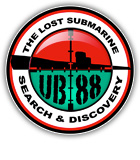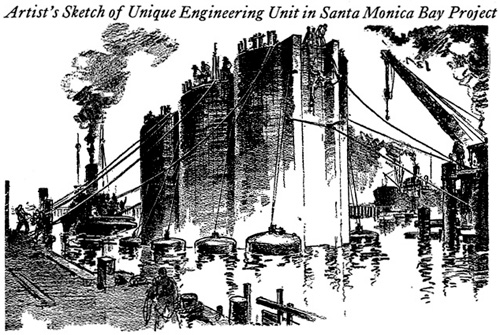
Scene at Long Beach when the first completed caisson in the
$690,000 Santa Monica Yacht Harbor project was successfully
launched.
Image from the Los Angeles Times Mar. 12, 1933
The
Caissons
Two man-made structures lie on the ocean floor just a few
short miles from Los Angeles Harbor. Separated by less than
a half mile, these identical structures, composed of three
vertical concrete cylinders, span a distance over 100 feet
and tower more than 30 feet above the seabed. "The
Caissons”, as they are commonly known, are a popular
destination for SCUBA divers capable of reaching their
depths over 140 feet below the surface.
While they do resemble a caisson used in bridge
construction work, their actual purpose has only been
speculated. Were they used to protect Los Angeles Harbor
during WWII? Were they used during the construction of the
Vincent Thomas Bridge in the 1960’s? Are they some
type of storage tanks? Or were they used as anchors for
offshore oil drilling platforms? How did they get here and
when were they sunk? These are some of the questions
surrounding the mystery of the Caissons that have remained
unanswered until now.
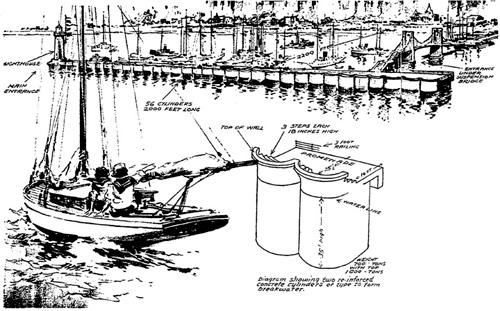
Image from the Los Angeles Times Dec. 13, 1931
Colorful
Haven Visioned at Yacht Harbor
The caissons or “concrete cribs” were part of
the original plans to construct the 2000 foot Santa Monica
Yacht Harbor Breakwater in 1933. The $690,000 project
called for eighteen such caissons to be placed side by
side, filled with sand, and anchored to the seafloor with
steel pilings. Designed by Howard B. Carter, City Engineer
of Santa Monica, each steel reinforced concrete caisson,
weighed 2100 tons, measured 111 feet long, thirty-five feet
wide at the base, thirty-six feet high, with a diameter of
twenty-eight feet at the tubular sides.
The exteriors of each unit would present curved surfaces to
the forces and currents of the surging sea. The three
arches on each side of the caisson would distribute the
water stresses on the unit equally, exactly as arches have
been used to absorb stresses equally in buildings and
bridges for centuries.
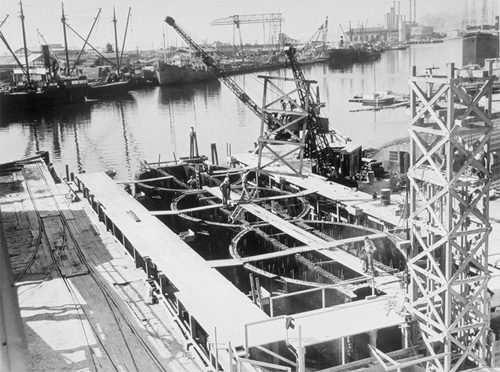
First caisson under construction.
Courtesy of the Santa Monica Public Library Image Archives
The giant caissons were built in a specially designed
graving dock at the Graham Brothers’ yard in Long
Beach, by the Puget Sound Bridge and Dredging Company, the
general contractors for the project. Each unit was
constructed with a false bottom for floating purposes.
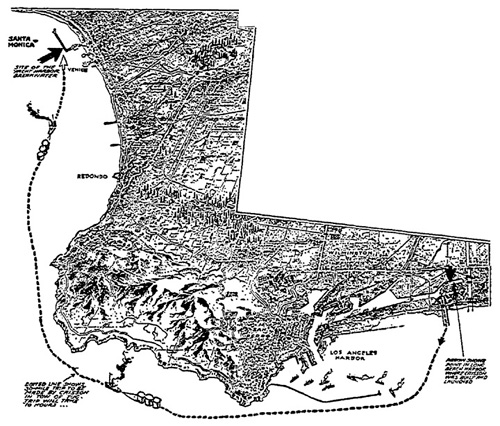
Image from the Los Angeles Times Mar. 12, 1933
Once built and allowed to harden for several weeks, the
first caisson was floated and towed by tug under the Edison
drawbridge and then the thirty miles around the coastline
to its final position in Santa Monica Bay. The occasion
marked the first time in the United States that an attempt
had been made to float a similar concrete construction in
an open sea.
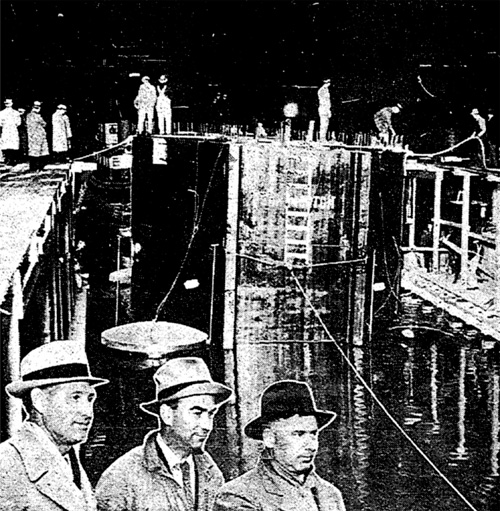
Photo from the Los Angeles Times Mar. 10, 1933
Concrete
Ship
Launching at Long Beach of the first crib for the Santa
Monica Yacht Harbor breakwater and inset, watching the
operations, Howard B. Carter, City Engineer of Santa
Monica, W. F. Way, engineer in charge, and N. S. Ross,
associate in the contracting firm of Puget Sound Bridge and
Dredging Company and W. F. Way, Inc., of Los Angeles.
As the crib was launched it bore the name of John Morton,
Commissioner of Public Works of Santa Monica. Each
following unit, which were to be completed at a rate of one
a week, were to be named after some beach city official.
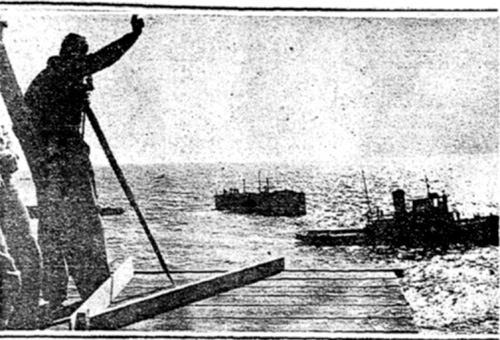
Photo from the Los Angeles Times Mar. 26, 1933
Floating
Breakwater Takes Trip to Home in Sea
Tugs stand by after towing caisson from Long Beach while
engineer on end of Santa Monica pier lines up spot on which
to sink caisson.
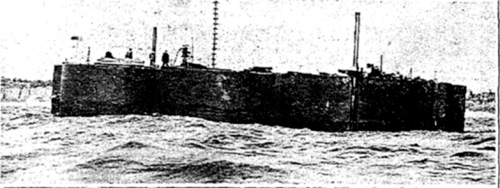
Close-up of caisson being lowered into position.
Photo from the Los Angeles Times Mar. 26, 1933
Ready to
Visit Davey Jones Locker
The plans for a crib type breakwater would come to an
abrupt end soon after the first caisson was lowered into
position. Sand scouring beneath the structure had caused
the unit to crack and soon the central cylinder collapsed.
The remains of the caisson were declared a menace to
navigation and cleared away with dynamite. A traditional
rock-mound type breakwater was eventually adopted in favor
of the crib type design.
At the time of the first caissons’ failure, three
completed caissons were still waiting at Long Beach for
installation. Obviously this would never happen and on May
27, 1935 the remaining sections were towed out to sea and
sunk. The location of the third caisson is not known, but
due to the close proximity of the dump site to the San
Pedro Valley, it’s possible the third caisson was
sunk in deep water and is gone forever.
Navy records from 1942 indicate that the U.S.S. Gilmer made
sonar contact and a subsequent depth charge attack on a
stationary object on the seafloor believed at the time to
be a possible enemy submarine. The range and bearing given
in the report matches precisely with the location of
Caisson #2. This attack would account for the severe damage
to one end of the caisson that is visible today.
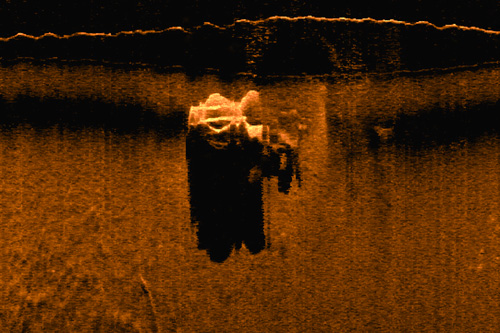
Side
scan sonar image of Caisson #2. The far right cylinder of
the caisson is completely destroyed along with half of the
center cylinder. The left cylinder is intact and the two
crossmembers are easily visible. The large acoustic shadow
gives a good sense of the 36 foot vertical relief of the
structure.
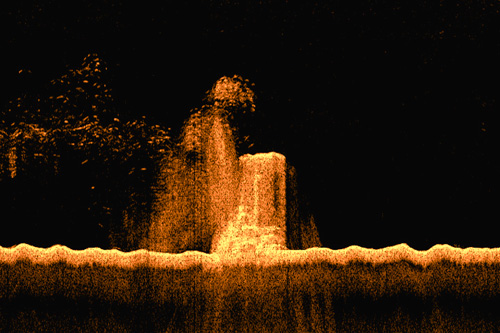
A
traditional sonar recording of Caisson #2. The sheer
vertical sides of the caisson are very evident as well as
the debris pile from the collapsed cylinders at the base of
the structure. A large population of fish make the Caissons
their home.
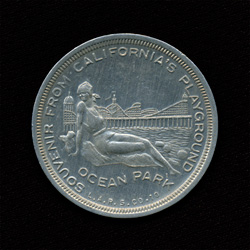
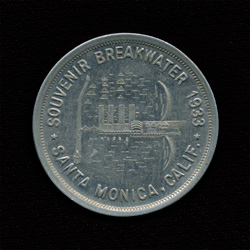
This
1933 Santa Monica Breakwater So-Called Dollar (HK-687) was
struck off to commemorate the start of the breakwater
project. The front of the coin (left) shows a young woman
sunbathing on the beach next to the Santa Monica Pier. The
back of the coin (right) depicts the completed breakwater
and yacht harbor. Note the suspension bridge connecting the
end of the pier to the breakwater. These coins can also be
found in brass, nickel, and a rare blue aluminum
version.
